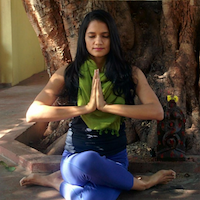The hallmarks of a meaningful yoga practice.
My parents have been following the path of yoga since before I was born, yet they’ve never stepped foot on a yoga mat.
Their yoga practice does not involve a multitude of postures, but simply a mantra and the ability to sit for two and a half hours daily in meditation.
It is quite contrary to the modern Western view of yoga, which is almost entirely centered around dynamic postures.
Today, yoga is practiced more for general good health or to cure specific diseases rather than enlightenment. That is why it is a billion-dollar industry and gaining popularity as a wellness practice. Various hybrids and offshoots have also evolved to make it more exciting and appealing as a fitness routine.
And this is indeed helpful for society at large, as benefits of yoga are manifold—but where does that leave the spiritual aspect of yoga?
Yoga for fitness and yoga for meditation—both have a place in the world today, but it can often create confusion as spiritual seekers find themselves exercising to the point of exhaustion and fitness enthusiasts end up Om-ing their way into pseudo-spirituality.
In all my time spent as a yoga practitioner, teacher, and a spiritual seeker, here are my observations on this conflict:
The number one objective of yoga is physical and mental relaxation.
Hatha yoga is the foundation of all physical asana practices of the modern world, and its primary objective is to make the body steady and light.
The goal is not just to become super flexible, as that would make us weak and unstable. Neither is it to get strong, bulky muscles, as that would make us dense, heavy, and obstruct energy flow.
The aim of yoga is to find that refined balance between both which effectively helps us relax the body and mind. And complete relaxation is the fundamental prerequisite to progress on the spiritual path. Because if we are mentally disturbed or physically weak and uncomfortable, we cannot focus or concentrate on anything.
There are many ways to induce such deep relaxation, but given the nature of our modern lifestyle, mindful movements like asanas, when coordinated with the breath, are a powerful tool to improve mind-body awareness.
They energize us without creating tension or stiffness and relax us without inducing dullness or lethargy. As we progress higher, we can even penetrate deep into our subconscious through meditative techniques described by the sage Patanjali.
Thus, the hallmark of a meaningful yoga practice is that over time, it should make us feel strong, relaxed, rejuvenated, and calm. If our methods are leaving us exhausted, breathless, agitated, competitive, or repeatedly injured, we need to introspect and reassess.
Asanas are not necessary, but they are beneficial.
We can indeed meditate and be spiritual even without asana practices.
But unless we have a natural affinity for meditation, we would need to put in some effort just to be able to sit still. Yoga practice is also helpful for sensitive, agitated, or restless temperaments. It can even help settle the mind during emotional conflicts, times of grief, or stressful phases of life.
In essence, having a consistent asana and pranayama practice will ensure we have a consistent meditation practice, no matter what curveball life throws our way.
However, we should not feel discouraged or intimidated by complicated yoga postures. We don’t need to do convoluted things with our body to experience the benefits of yoga.
To aid meditation, a mindful yoga practice with even simple yoga asanas and some breathing techniques is generally sufficient. With consistent practice, our capacity and mobility will naturally keep improving, and we may end up progressing to advanced asanas. If it happens, great, and if it doesn’t, so be it. In the case of asanas, the journey is the reward.
However, be mindful of the ego.
Advanced yoga asanas have a unique thrill, and achieving a difficult posture is indeed commendable. It has some spiritual benefits too—we gain mental strength and confidence, we overcome fear, and we learn that consistent practice and doing the same thing repeatedly gives results.
All these lessons are extremely important for meditators. Reading about them in theory a hundred times will make no difference, but experiencing them in practice even once, such as on a mat, creates a strong impression on our subconscious.
Though we quickly lose all of that benefit as soon as our ego takes over—the thrill of achieving postures also strengthens the feeling of “I-ness” and increases identification with the physical body (vanity). And whatever we learn on the mat, we take with us in our day-to-day lives.
My teacher would often jokingly say: “Do a headstand daily without counter positions and in three months your family will throw you out of the house”—it would make us just that egoistic and difficult to deal with.
This was primarily why Swami Vivekananda criticized Hatha yogis—he felt the glory of physical pursuits easily distracted them from the spiritual path.
So, if we’re spiritually inclined, we should be mindful of this ego and must remember that enlightenment is not conditional on our ability to stand on our head. Most notable, sages simply had the quality of sitting still for long periods of time.
Do not confuse the role of modern yoga teachers and spiritual gurus.
A contemporary yoga teacher is not necessarily a spiritual guru—that is a presumption and stereotype that many fall prey to, and one that we should firmly set aside.
There are popular yoga influencers who mobilize millions of their followers under the garb of yogic values for business gains. The yoga community is also rife with sexual abuse and self-proclaimed yoga gurus taking advantage of innocent students—we don’t need more of such incidents. We must respect all our teachers, but we should be cautious who we are taking spiritual guidance from.
Modern yoga teachers are specialists in some or all techniques of mind-body awareness. They would have invested time, money, and a lot of earnest effort to get trained in a specific skill. Some may have a spiritual inclination, and some may not. Some may follow traditional yogic values, and some may not.
Just as all economics professors in a business school will have different qualifications, so too will every yoga teacher bring a unique perspective to a practice. Different teachers will suit different people as they enable students at different levels to progress further.
But ethics, morals, and a criteria of good respectable behavior that apply to the rest of the world apply to yoga teachers as well. Their spiritual inclination is not an excuse for any civil exception. Because as far as the spiritual journey is concerned, we the teachers and we the students are all contemporaries. And as responsible yoga teachers, we must also refrain from leading our students down a path we are not qualified for.
We can, of course, share our journey, but we must remember that a teacher can only take a student as far as he or she has been herself.
Develop good habits.
The practice of yoga is not limited to a mat or a meditation cushion.
If we genuinely want to advance in yoga or spirituality, we will need to put in a lot of work beyond the class and off the mat—that’s where advanced yoga practice happens.
It’s in our interactions with people, in our attitude, how we treat our coworkers, how honest we are when no one is watching, what we think about all day, what we eat, and so on.
But such teachers who can guide us on this journey are not many. So, until we find such a teacher, we will need to rely on guidance from within or spiritual studies. Any suitable spiritual books, preferably in their original language, or writings of reputed sages should be read repeatedly throughout our lives.
Personally, I would recommend the Yoga Sutras of Patanjali and the Bhagavad Gita.
Keep good company.
The stories of people wanting to renounce their families and lives to move into an ashram or becoming enamored by a guru and making regretful decisions are not uncommon in the spiritual world.
The great oratory skills and charming personalities of spiritual sociopaths can sometimes blindside us. Or, if we are in an emotionally vulnerable phase of life, we may end up becoming too attached to a philosophy or person who may be unhealthy for us. Our friends and family are the most powerful weapons of protection against such decisions. Always be open to the people who have stood by you and supported you throughout your life.
The truth is, while a few cases of renunciation or attachment may be genuine, most are not. It is normal human tendency to want to give up everything and the idea of a yoga ashram is indeed romantic, but a misconception.
Often, spirituality or spiritual personalities become an escape route from the onslaught of our daily responsibilities and a way to cope with our inherent weaknesses. Either we need to be self-aware to identify such traits in us, or we need to have a strong support system by way of well-wishers who can prevent us from becoming our own worst enemy.
And always remember that the spiritual path does not require us to give up our worldly lives—an entire holy book, the Bhagavad Gita, has been written on this topic.
Conclusion:
“He who would learn to fly one day must first learn to stand and walk and run and climb and dance; one cannot fly into flying.” ~ Nietzsche
Hatha yoga gives us those preliminary practices that help prepare us for higher meditative pursuits. Asanas alter our consciousness by physically manipulating the body and help us relax and de-stress, and they improve our relationship with the breath through pranayama.
And with that foundation in place, we can start our spiritual journey on a stable footing—no matter what our chosen spiritual path is.
Yoga postures are relevant because they help us de-stress, focus, and concentrate better on whichever symbol or God we may choose to. Along the way, there will be pitfalls, and that’s why spiritual studies, as well as a good company, are essential to ensure we don’t stray from the path.
~









Read 0 comments and reply